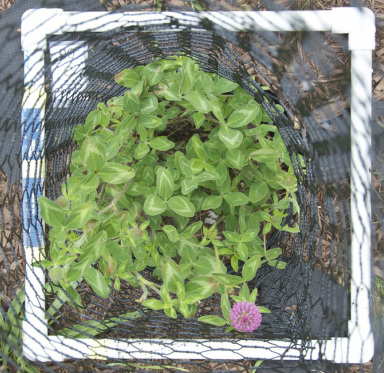The independent and combined effect of consumption and competition with exotic plants on native plant growth and herbivory
Question/Background/Methods
Biological invasions are a major threat to ecological communities and biotic interactions likely play an important role in regulating the impact of exotic plant species on native plant species. Interspecific competition and herbivory are two important biotic factors that govern native plant growth, yet understanding of how both herbivory and interspecific competition with exotic plants interact to impact native plant growth is limited. Using a field experiment, I examined the independent and combined effects of competition and herbivory by planting the native forb Asclepias syriaca (common milkweed) in the presence and absence of exotic competitors (Trifolium pratense and Leucanthemum vulgare) and manipulated the access (caged, open) mammal herbivores had to experimental plots. To further explore the effect of exotic plant neighbors on the intensity of competition and herbivory, the density and diversity of both exotic plants growing in association with A. syriaca was manipulated.
Results/Conclusion
Competition with exotic plants and herbivory reduced native plant biomass and height; however, exotic plant identity and diversity differentially affected the intensity of both biotic factors. In the absence of interspecific competition, herbivory reduced native plant biomass and height by 81% and 67%, respectively. In the absence of herbivory, the effect of competition with L. vulgare on A. syriaca growth was much stronger compared to competition with T. pratense. In the presence of herbivores, T. pratense had a positive effect on A. syriaca biomass compared to plots where A. syriaca grew with conspecifics, only L. vulgare, and both exotic species. Furthermore, herbivory did not influence the effect of competition with exotic plants on A. syriaca stem biomass, but did influence the effect of competition on mean A. syriaca height. When A. syriaca grew with T. pratense and both exotic species, herbivory reduced mean A. syriaca height by 46% and 44%, respectively. This research demonstrates that experimentally examining the effect of multiple combinations of co-occurring exotic plant species on the intensity of interspecific competition and herbivory on native plant species can broaden understanding of the potential ecological impacts of biological invasion.
Biological invasions are a major threat to ecological communities and biotic interactions likely play an important role in regulating the impact of exotic plant species on native plant species. Interspecific competition and herbivory are two important biotic factors that govern native plant growth, yet understanding of how both herbivory and interspecific competition with exotic plants interact to impact native plant growth is limited. Using a field experiment, I examined the independent and combined effects of competition and herbivory by planting the native forb Asclepias syriaca (common milkweed) in the presence and absence of exotic competitors (Trifolium pratense and Leucanthemum vulgare) and manipulated the access (caged, open) mammal herbivores had to experimental plots. To further explore the effect of exotic plant neighbors on the intensity of competition and herbivory, the density and diversity of both exotic plants growing in association with A. syriaca was manipulated.
Results/Conclusion
Competition with exotic plants and herbivory reduced native plant biomass and height; however, exotic plant identity and diversity differentially affected the intensity of both biotic factors. In the absence of interspecific competition, herbivory reduced native plant biomass and height by 81% and 67%, respectively. In the absence of herbivory, the effect of competition with L. vulgare on A. syriaca growth was much stronger compared to competition with T. pratense. In the presence of herbivores, T. pratense had a positive effect on A. syriaca biomass compared to plots where A. syriaca grew with conspecifics, only L. vulgare, and both exotic species. Furthermore, herbivory did not influence the effect of competition with exotic plants on A. syriaca stem biomass, but did influence the effect of competition on mean A. syriaca height. When A. syriaca grew with T. pratense and both exotic species, herbivory reduced mean A. syriaca height by 46% and 44%, respectively. This research demonstrates that experimentally examining the effect of multiple combinations of co-occurring exotic plant species on the intensity of interspecific competition and herbivory on native plant species can broaden understanding of the potential ecological impacts of biological invasion.


